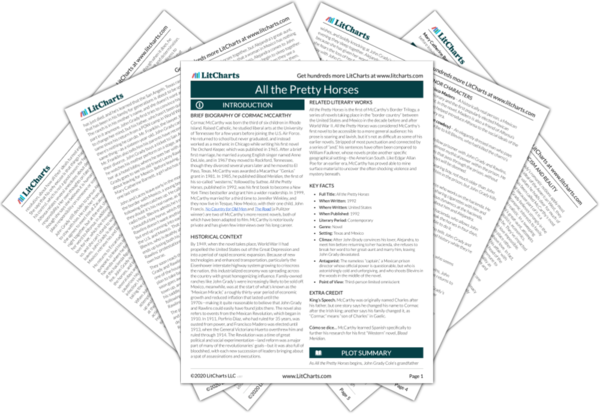The Idea of the American West
Most readers of Cormac McCarthy will already be familiar with his setting—southern Texas and northern Mexico—from the long tradition of American Westerns, filled with cowboys and gunfights on wide-open terrain. By the time the novel takes place, in 1949, this world is no longer to be found in Texas. Instead it has become a myth, one filled with powerful values of freedom and honor, which John Grady Cole and Lacey Rawlins set off in search…
read analysis of The Idea of the American WestRomanticism and Reality
While John Grady’s romantic notions apply most powerfully to his ideal of the American West, they also apply to other values he holds dear for much of the novel. All the Pretty Horses has been called McCarthy’s most romantic novel, and that’s not just because part of it is a romance story: it’s because John Grady believes strongly in the power of love to conquer all, from economic interests to family concerns. Other characters…
read analysis of Romanticism and RealityInnocence, Expertise, and Knowledge
In several ways, John Grady seems older than his sixteen years. Throughout his time in Mexico, John Grady is able to draw on the skills he learned growing up on a ranch, where he was responsible for many of the ranch’s daily activities. John Grady gains respect and admiration for his skill with horses: the hacendado is impressed by this expertise and gives him a special job at the hacienda taking care of them…
read analysis of Innocence, Expertise, and Knowledge
Fate and Responsibility
Is taking responsibility for one’s own actions an essential part of growing up, of accepting what it means to be human? Or is it simply hubris to assume that humans can escape or conquer fate? The novel doesn’t take a clear-cut position either way. Instead, the characters struggle to determine what they are responsible for and what remains beyond their control. During a long conversation between John Grady and Alfonsa, she mentions a story…
read analysis of Fate and ResponsibilityMeaningful and Gratuitous Violence
Some readers might recoil at the violence of All the Pretty Horses, which ranges from graphic portrayals to bleak descriptions. Different characters take different attitudes towards violence, regarding if and when it can be justified, and how closely it may be tied to revenge and justice. As a whole, the novel seems to distinguish between different kinds of violence, but it also remains committed to portraying violent acts as a method of literary realism—showing how…
read analysis of Meaningful and Gratuitous ViolenceLoyalty and Belonging
One way John Grady escapes from the constant, uncertain loop of fate and responsibility is by clinging to the value of loyalty above all else. We know from early on that John Grady is fiercely loyal to his ranch—he makes various attempts to prevent it from being sold, and finally decides that he himself must leave rather than see the ranch leave his family’s possession. For the rest of the novel, loyalty directs his actions…
read analysis of Loyalty and Belonging






